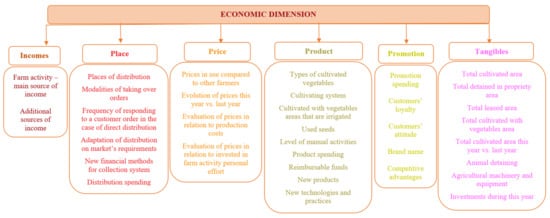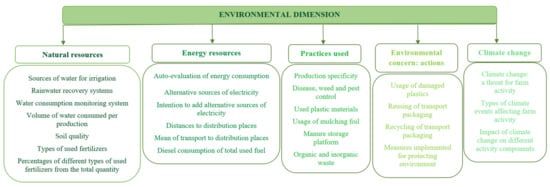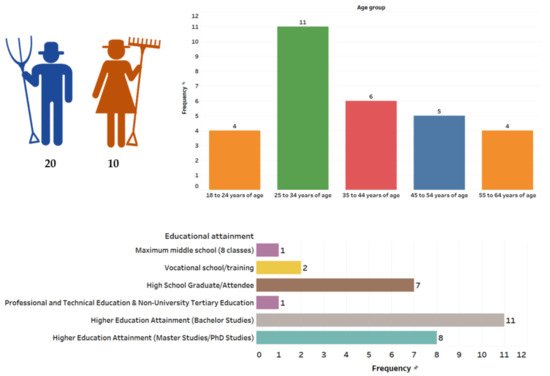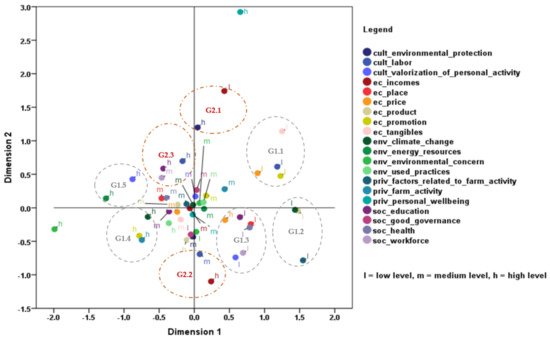
| Version | Summary | Created by | Modification | Content Size | Created at | Operation |
|---|---|---|---|---|---|---|
| 1 | Ioan-Sebastian Brumă | + 4161 word(s) | 4161 | 2021-09-18 05:56:01 | | | |
| 2 | Jason Zhu | Meta information modification | 4161 | 2021-09-22 04:31:58 | | | | |
| 3 | Jason Zhu | Meta information modification | 4161 | 2021-09-22 10:00:39 | | |
Video Upload Options
Considering that sustainability is a relative concept, but also that this limitation could be avoided through continuous adaptation of the evaluation tools by taking into account the directions of change (such as time, space, application domain), the goal of the present study is to elaborate a matrix for measuring the level of sustainability for small vegetable farms.
1. Introduction
Sustainability represents one of the main concerns for the agricultural domain [1][2], related to the idea of sustainable agriculture as a way of achieving some of the sustainable development goals[3][4]. Closely related to this, food sustainability is one of[13][14] the concepts considered important to achieving global sustainable development, potentially improving the efficiency and sustainability of resource use, while simultaneously reducing natural resource damage and waste.
Local food supplies are generally considered more sustainable because they take into account all three dimensions of sustainability, while producing economic benefits, generating environmental positive effects, and creating a favorable social impact[5]. In addition, many studies found that consumers often perceive local foods as more sustainable than non-local foods. Still, (1) local foods are not necessarily more environmentally sustainable ; (2) social impacts are also highly relevant, because consumers prefer local foods to support regional farms [6][7][8]; (3) sustainability has become an arena of competition among companies. In the food sector, a diffuse perception of the unsustainability of “big food” [9][10] has opened the way to a myriad of “local food” initiatives. The “local” has been frequently associated with sustainable and healthy production and consumption patterns [11][12], allowing “weak” actors in the system—in particular, farmers—to challenge “big food” with alternative principles, values, organizational patterns, and business models .
In this context, some of the benefits of an organizational evaluation in terms of sustainability should be mentioned. At the company level, it may prove effective to explore best practices, benchmarks, critical points, and errors to avoid. At the consumer level, the comparative sustainability assessment can promote more informed choices, based on multiple criteria of economic, social, ethical, health, and environmental impact of food behavior. At the policy level, it can help better understand the synergies between configurations and the dynamics that integration may generate in relation to the desired policy goals. This type of assessment can assist decision-making and strategic planning throughout the entire policy cycle (p. 4), (p. 99). Comparative sustainable assessment could also be the basis for a “social contract” approach to corporate responsibility [14], as a possible way for providing a higher volume of public goods capable of increasing the total obtained income [17] (p. 275).
As an implication of the evolution in the development theory, a better understanding of the principal components of sustainable development in different areas of activity remains one of the major current issues, because, apparently, the principle of sustainable development is not sufficiently put into practice and also not sufficiently understood for a proper evaluation in different contexts. However, proponents of sustainable development differ in their perspectives on what is to be sustained, what is to be developed, and how to link the environment to the different dimensions of society [18] (p. 560). In this context, the definitional ambiguities concerning sustainable development are frequently mentioned [18,19,20,21,22], justifying the amount of work dedicated to developing quantitative indicators used for measurements (such as [1][23][24][25][26][27][30][31][32]).
Assessment of the sustainability of different farming systems is a challenging process including several steps, such as: identification of stakeholder groups, selection of experts, issues, and weights that illustrate the roughly similar influence of various aspects and sustainability dimensions [35][36][37]. In addition, the sector of agriculture is divided into different sub-sectors (as the one of vegetable production) characterized by specific features that, accordingly, require special attention. This extra element reveals the complexity of the evaluating process of agricultural sustainability and constitutes a premise for considering it of foremost significance for the authors of this paper.
A series of major arguments support the importance of measuring sustainability through developing a sustainability tool for the vegetable production system [32][33][34][40][42][43][44][45][41][46][47][48].
Firstly, sustainability represents a relative concept that fluctuates in terms of meaning, being determined by the evolution of a society as a whole. Moreover, as Gómez-Limón and Riesgo [31] (p. 3345) pointed out, moving on to a narrower area of analysis, that agricultural sustainability translates into “the ability of agricultural systems to satisfy different demands as times change”. Hence, it is underlined the constant need of updating this concept based on the changes registered at societal level and in specific areas of analysis, such as the production of vegetables, in this case. Accordingly, what sustainability means must be specific to time and place [31] (p. 3345), and yet also specific to the topical domain of application [33]. The fact that sustainability represents a relative concept was considered as one of its limits, hindering its usefulness as a criterion for guiding the development process in different areas of interest [31] (p. 3345). This limit may be avoided through continuous adaptation of its evaluation tools, while taking into consideration the major directions of change, such as: time, space, and domain of application.
Secondly, although the major scope of a food system is to produce food commodities based on economic reasons, the producers also need to consider the effects of the environmental and social dimensions of their activities along the entire product life cycle [32][38][39][40]. Based on this evaluation, the directions of proper actions that answer to the desideratum of sustainability might be possibly formulated.
Thirdly, there is always room for improving the analysis of the sustainability phenomenon, as “thanks to Walras, Pareto or Nash, we will be convinced there are no ideal models of sustainability” [19] (p. 25).
Fourthly, a new reconfiguration in terms of food and health security, as a consequence of the new context imposed by the actual sanitary crisis, can be noticed. People tend to register a higher awareness on the importance of health in their life [41,42] and, consequently, become more health-oriented in terms of food [42,43,44]. In some countries, due to the crisis triggered by the COVID-19 pandemic, people started to purchase more fresh vegetables and food, both directly and online, from local producers/processors [45,46]. In the light of our new actual sanitary context and along with the fact that sustainability, through its objectives, represents a major goal in itself, always striving for improvement and adaptation in constantly changing contexts that in their turn, ask for new ways of analysis and measurement, a novel approach could be recommended for appreciating the sustainability of vegetable production systems. Similar approaches have been proposed by Gómez-Limón and Riesgo [31], Talukder et al. [1], Iocola et al. [47], and De Olde [48]. Each of them tried to respond as properly as possible to their analyzed context, necessarily to be taken into consideration when proposing such a tool; still, their application remains limited and necessarily adaptable to new contexts, as a function of other specific proposed goals.
Consequently, the main aim of this study is to run a diagnostic on sustainability for the vegetable production system, with focus on the North-East Development Region of Romania. Thus, we are looking to attain a clear image of what sustainability could represent in this area, dividing its main features into four main dimensions (economic, social, environmental, and cultural), while adding the private dimension. Although the first three dimensions are the most commonly ones in the approaches regarding sustainability, the dimension related to the cultural aspect is also not exactly new, it has been already met in various studies, such as those of Horlings [49], Axelsson et al. [50], Chiu [51], Scerri and James [52], Al Shamsi et al. [33], Peano et al. [53], the main justification being that culture supports ways of actions almost throughout, whether if refers to work, co-operation, labor division, environmental attitudes, and so on. Further on, this study would like to discuss a new dimension, i.e., the private one, which we consider essential when, although “it is of the ensemble” [19] (p. 24), sustainability is put into practice by individual initiatives characterized by specific features that should not be neglected. Individualism, and not holism, as a principle of judgment, remains the distinctive feature of constructing and acceding to economic welfare [19] (p. 5), as the basis for the other dimensions of sustainability [27], without which neither social nor environmental dimensions could be supported in their process of attaining a sustainable path, their status representing “a consequence rather than a starting point” [19] (p. 24). Therefore, following Smith [54], the individual initiative is the main resort of bringing about transformation [19,55,56]. Consequently, our study firstly analyzes a specific type of this individual entrepreneurial initiative and, secondly, given the importance of the personal component in the development path of an individual initiative, also integrates among sustainability’s dimensions the private one, characterized by personal peculiarities capable of enriching the ability to comprehend the whole perspective upon a sustainable activity.
2. Methodology of Constructing a Sustainability Matrix for the Vegetable Production System

2.1. Composition of the Sustainability Matrix—Economic Dimension

2.2. Composition of the Sustainability Matrix—Social Dimension

2.3. Composition of the Sustainability Matrix—Environmental Dimension

2.4. Composition of the Sustainability Matrix—Cultural Dimension
2.5. Composition of the Sustainability Matrix—Private Dimension
4. Results
4.1. Descriptive Analysis

4.2. Multiple Correspondence Analysis (MCA)

4.3. Descriptive Analysis of Different Types of Production Systems
References
- Shamsi, K.B.A.; Compagnoni, A.; Timpanaro, G.; Cosentino, S.L.; Guarnaccia, P. A Sustainable Organic Production Model for “Food Sovereignty” in the United Arab Emirates and Sicily-Italy. Sustainability 2018, 10, 620.
- Avram, M.; Avram, V. The Accountancy of the Tangible Assets According to the European Directives. In Proceedings of the International Conference Knowledge-Based Organization Economic Social Administrative Approaches to Knowledge-Based Organization, Sibiu, Romania, 25–27 November 2010; pp. 139–146.
- Aleskerova, Y.; Fedoryshyna, L.; Koval, N. Features of Loan Security for the Reproduction of Fixed Assets for Agricultural Purposes. Balt. J. Econ. Stud. 2018, 4, 1–5.
- Dodor, A. Exploring Marketing Mix for Building a Viable Agro Business. Br. J. Educ. Soc. Behav. Sci. 2015, 6, 78–86.
- Maxim, A.; Străjeru, S.; Albu, C.; Sandor, M.; Mihalescu, L.; Pauliuc, S.E. Conservation of vegetable genetic diversity in Transylvania-Romania. Sci. Rep. 2020, 10, 18416.
- Rubatzky, V.E.; Yamaguchi, M. World Vegetables: Principles, Production, and Nutritive Values; Springer: Boston, MA, USA, 1997.
- Masuku, M.B.; Xaba, B. Factors Affecting the Productivity and Profitability of Vegetables Production in Swaziland. J. Agric. Stud. 2013, 1, 37–52.
- Malak-Rawlikowska, A.; Majewski, E.; Wąs, A.; Borgen, S.O.; Csillag, P.; Donati, M.; Freeman, R.; Hoàng, V.; Lecoeur, J.-L.; Mancini, M.C.; et al. Measuring the Economic, Environmental, and Social Sustainability of Short Food Supply Chains. Sustainability 2019, 11, 4004.
- Binswanger, H. The Policy Response of Agriculture. World Bank Econ. Rev. 1989, 3, 231–258.
- Ulman, S.-R.; Dobay, K.-M. Environmental Protection in Romania: Perceptions versus Active Participation. Environ. Eng. Manag. J. 2020, 19, 183–194.
- Cachon, G.P.; Swinney, R. The Value of Fast Fashion: Quick Response, Enhanced Design, and Strategic Consumer Behavior. Manag. Sci. 2011, 57, 778–795.
- Kitchen, P.J.; Brignell, J.; Li, T.; Jones, G.S. The Emergence of IMC: A Theoretical Perspective. J. Advert. Res. 1999, 44, 19–30.
- Miglak-Krajewska, M.; Wojciechowska-Solis, J.; Viti, D. Consumers’ Purchasing Intentions on the Legume Market as Evidence of Sustainable Behaviour. Agriculture 2020, 10, 424.
- Boca, G. Factors Influencing Consumer Behavior in Sustainable Fruit and Vegetable Consumption in Maramures County, Romania. Sustainability 2021, 13, 1812.
- Heikkilä, J. From supply to demand chain management: Efficiency and customer satisfaction. J. Oper. Manag. 2002, 20, 747–767.
- Cambra-Fierro, J.J.; Polo-Redondo, Y. Creating satisfaction in the demand-supply chain: The buyers’ perspective. Supply Chain Manag. Int. J. 2008, 13, 211–224.
- Quayle, M. A study of supply chain management practice in UK industrial SMEs. Supply Chain Manag. Int. J. 2003, 8, 79–86.
- Majewski, E.; Komerska, A.; Kwiatkowski, J.; Malak-Rawlikowska, A.; Wąs, A.; Sulewski, P.; Gołaś, M.; Pogodzińska, K.; Lecoeur, J.-L.; Tocco, B.; et al. Are Short Food Supply Chains More Environmentally Sustainable than Long Chains? A Life Cycle Assessment (LCA) of the Eco-Efficiency of Food Chains in Selected EU Countries. Energies 2020, 13, 4853.
- Brumă, I.; Vasiliu, C.; Rodino, S.; Butu, M.; Tanasă, L.; Doboș, S.; Butu, A.; Coca, O.; Stefan, G. The Behavior of Dairy Consumers in Short Food Supply Chains during COVID-19 Pandemic in Suceava Area, Romania. Sustainability 2021, 13, 3072.
- Butu, A.; Brumă, I.S.; Tanasă, L.; Rodino, S.; Vasiliu, C.D.; Doboș, S.; Butu, M. The Impact of COVID-19 Crisis upon the Consumer Buying Behavior of Fresh Vegetables Directly from Local Producers. Case Study: The Quarantined Area of Suceava County, Romania. Int. J. Environ. Res. Public Health 2020, 17, 5485.
- Chiffoleau, Y.; Dourian, T. Sustainable Food Supply Chains: Is Shortening the Answer? A Literature Review for a Research and Innovation Agenda. Sustainability 2020, 12, 9831.
- Mayraz, G.; Schupp, J.; Wagner, G. Life Satisfaction and Relative Income: Perceptions and Evidence; The Institute for the Study of Labor (IZA): Bonn, Germany, 2009.
- Wolbring, T.; Keuschnigg, M.; Negele, E. Needs, Comparisons, and Adaptation: The Importance of Relative Income for Life Satisfaction. Eur. Sociol. Rev. 2013, 29, 86–104.
- Jāhāna, S. Human Development Report 2016: Human Development for Everyone; United Nations Publications: New York, NY, USA, 2016.
- Van de Kerk, G.; Manuel, A. Sustainable Society Index—Your Compass to Sustainability; Sustainable Society Foundation: The Netherlands, 2017.
- Kowalski, S.; Veit, W. Sustainable Society Index—Your Compass To Sustainability. Available online: https://ssi.wi.th-koeln.de/ (accessed on 20 March 2021).
- Sen, A.K. Development as Freedom; Oxford University Press: New York, NY, USA, 1999.
- Kanbur, R.; Squire, L. The Evolution of Thinking about Poverty: Exploring the Interactions. In Frontiers of Development Economics—The Future Perspective; Meier, G.M., Stiglitz, J.E., Eds.; Oxford University Press: New York, NY, USA, 2001.
- Gómez-Limón, J.A.; Riesgo, L. Alternative approaches to the construction of a composite indicator of agricultural sustainability: An application to irrigated agriculture in the Duero basin in Spain. J. Environ. Manag. 2009, 90, 3345–3362.
- Onsrud, H.J.; Taylor & Francis Group. Legal and Policy Paths for Effective Sustainable Development. In Development Goals Connectivity Dilemma Land and Geospatial Information for Urban and Rural Resilience; Rajabifard, A., Ed.; CRC Press: Boca Raton, FL, USA, 2020.
- Blewitt, J. Understanding Sustainable Development; Routledge: New York, NY, USA, 2015.
- World Bank. The Worldwide Governance Indicators (WGI). Available online: https://info.worldbank.org/governance/wgi/ (accessed on 10 November 2019).
- Talukder, B.; Blay-Palmer, A.; Vanloon, G.W.; Hipel, K.W. Towards complexity of agricultural sustainability assessment: Main issues and concerns. Environ. Sustain. Indic. 2020, 6, 100038.
- Auty, R.M. How Natural Resources Affect Economic Development. Dev. Policy Rev. 2000, 18, 347–364.
- Terry, L.K. The Paradox of Plenty: Oil Booms and Petro-States; University of California Press: Berkeley, CA, USA, 1997.
- Sachs, J.; Warner, A. Natural Resource Abundance and Economic Growth; National Bureau of Economic Research: Cambridge, MA, USA, 1995.
- Khan, I.; Hou, F.; Le, H.P. The impact of natural resources, energy consumption, and population growth on environmental quality: Fresh evidence from the United States of America. Sci. Total. Environ. 2021, 754, 142222.
- Catton, W.R.; Dunlap, R.E. A New Ecological Paradigm for Post-Exuberant Sociology. Am. Behav. Sci. 1980, 24, 15–47.
- Vitousek, P.M.; Ehrlich, P.R.; Ehrlich, A.H.; Matson, P.A. Human Appropriation of the Products of Photosynthesis. BioScience 1986, 36, 368–373.
- Hinrichs, R.A.; Kleinbach, M. Energy: Its Use and the Environment; Cole Cengage Learning: Boston, MA, USA, 2012.
- Hill, R.; O’Keefe, P.; Snape, C. The Future of Energy Use; Earthscan Publications Ltd.: London, UK, 1995.
- Adegbeye, M.; Reddy, P.R.K.; Obaisi, A.; Elghandour, M.; Oyebamiji, K.; Salem, A.; Morakinyo-Fasipe, O.; Cipriano-Salazar, M.; Camacho-Díaz, L. Sustainable agriculture options for production, greenhouse gasses and pollution alleviation, and nutrient recycling in emerging and transitional nations—An overview. J. Clean. Prod. 2020, 242, 118319.
- Brieger, S.A. Social Identity and Environmental Concern: The Importance of Contextual Effects. Environ. Behav. 2019, 51, 828–855.
- Diekmann, A.; Franzen, A. Environmental Concern: A Global Perspective. In Einstellungen und Verhalten in der empirischen Sozialforschung; Springer Science and Business Media LLC: Berlin, Germany, 2019; pp. 253–272.
- Dunlap, R.E.; Scarce, R. Poll Trends: Environmental Problems and Protection. Public Opin. Q. 1991, 55, 651–672.
- Dunlap, R.E.; York, R. The Globalization of Environmental Concern and The Limits of The Postmaterialist Values Explanation: Evidence from Four Multinational Surveys. Sociol. Q. 2008, 49, 529–563.
- Gatti, R.C. Trends in human development and environmental protection. Int. J. Environ. Stud. 2016, 73, 268–276.
- Inglehart, R. Public Support for Environmental Protection: Objective Problems and Subjective Values in 43 Societies. PS Polit. Sci. Polit. 1995, 28, 57.
- Kemmelmeier, M.; Król, G.; Kim, Y.H. Values, Economics, and Proenvironmental Attitudes in 22 Societies. Cross-Cultural Res. 2002, 36, 256–285.
- Poortinga, W.; Steg, L.; Vlek, C. Values, Environmental Concern, and Environmental Behavior: A Study into Household Energy Use. Environ. Behav. 2004, 36, 70–93.
- Sneddon, C.; Howarth, R.; Norgaard, R.B. Sustainable development in a post-Brundtland world. Ecol. Econ. 2006, 57, 253–268.
- FAO. FAO’s Work on Climate Change United Nations Climate Change Conference in 2016; FAO: Rome, Italy, 2016.




